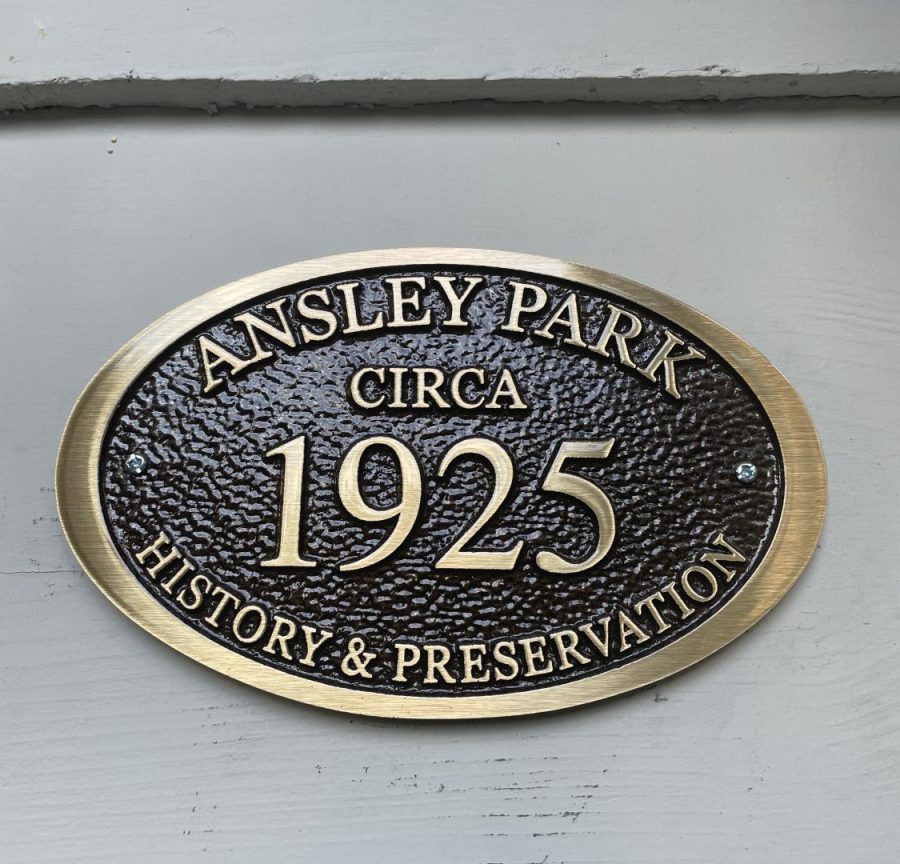Ansley Park’s possible historic district causes mixed feelings from residents
This is a plaque that residents in Ansley Park can apply for to be put on their homes to show what year they were built.
September 13, 2022
In response to recent increases in demolition of homes in the Ansley Park area, Ansley Park Forever (APF) was made in partenership with the Ansley Park Civic Association (APCA), with hopes to designate the neighborhood a historic district. The neighborhood has over 120 historic homes, far fewer than it had before.
“In recent years, a steadily increasing number of older, historic homes in Ansley Park have been demolished and replaced by new construction and infill development,” long-time Ansley Park resident Lisa Cassilly said. “In the process, a great number of trees have been removed. As a result, the APCA, an association comprised of Ansley Park residents, formed a committee made up of a cross-section of neighbors to explore ways by which the neighborhood could preserve its historic character, streetscape and quality of life.”
The rate of demolitions in the area is what drives APF.
“We’re starting to see more and more [demolitions],” Cassilly said. “There are some streets where I counted the houses myself and out of 12 houses on one side of the road, at least eight of them are relatively new houses. Only four of the 12 are houses that would date before 1960.”
APF hopes to control the zoning about the historical district and what homeowners can and cannot do with their properties, which has created a backlash from many residents.
“I don’t think there should be any of these rules put in place,” Andy Maurer, leader of Advocates for Ansley Park (AAP), said. “The existing zoning rules that we have, the existing lot coverage rules and the existing height rules are just fine and they [have] served the neighborhood well for the history of Ansley Park over the last hundred 120 years. So, the idea that this is somehow a positive for the neighborhood and these additional rules are somehow going to be beneficial is just false.”
As a result of financing issues, APCA is facing a lawsuit.
“The Civic Association has used the money that members are contributing, even though their bylaws don’t allow that,” Maurer said. “The lawsuit, initially, is seeking an injunction which is where the court would order them to stop this effort. You know, individuals could still pursue it as individuals, but they couldn’t use the Civic Association’s resources or money.”
Resident and Ansley Park homeowner Marshall Norseng is not fully on board with APF’s ideas either, but appreciates what the organization is trying to do for the community.
“In a neighborhood meeting it sometimes seems like those who already have built big, new, remodeled houses are seeking to preserve their views at the expense of those of us who live in houses that are still close to their original state,” Norseng said. “Most of these houses aren’t historic in the conventional sense, they are old, and just like all neighbors before us had the right to do, we should be allowed to update them as we wish.”
Cassilly agrees with APF and what they’re trying to achieve in the neighborhood.
“I am very much in favor of seeking a historic or landmark designation and adopting a set of reasonable controls that permit property owners to make decisions about their property, while at the same time balancing the need to protect the unique character and quality of life in the neighborhood,” Cassilly said.
Many other homeowners were against the first draft of home restrictions released by APF.
“One example of restrictive rules in the draft would be that there are a lot of teardowns in the neighborhood, people buying houses that then get knocked down and rebuild new houses,” Maurer said. “For many homeowners, myself included, that would not be possible. For the same homeowners, there would be a requirement to preserve the front facade plus eight feet on the side of the house. So making changes or modifications to my house or other people’s homes would become more difficult or even impossible.”
While in the proposing and planning phase, the limitations still created a huge concern and could be seen as slightly unfair.
“In the draft proposals, there are a lot of minutiae like fence height, dormer setbacks, facade style and more, but the biggest restriction is likely to be that older homes could not be torn down except in extreme circumstances,” Norseng said. “Most houses weren’t built to last forever. Even with a lot of TLC the lack of energy efficiency, continually cracking plaster walls, and water permeable brick foundation, at some point, become prohibitively expensive to retrofit onto old houses. It’s the normal cycle for houses to eventually be replaced with something newer and better.”
Because of the heavy vocal opposition from some residents, APF is making multiple changes as well as consulting neighbors for future modifications. They are also getting their opinions on draft regarding what homeowners can and can’t do to their homes.
“In the first draft, there was some objection by a number of neighbors, saying that it was too limiting and they had valid points, and so that’s why it’s still being worked through,” Cassilly said. “They’re gathering information from neighbors to revise and they’re circulating this new set of proposals which hopefully will have greater support because it is supposed to reflect feedback from the community.”
If the rules are put in place, it will have a huge impact on the community, which some see as positive and others see as negative.
“While I don’t agree with the proposal or their approach, I think the effort speaks to how much organizers love the neighborhood,” Norseng said. “That said, a large number of residents who love the neighborhood just as much are against making it a historic district.”







